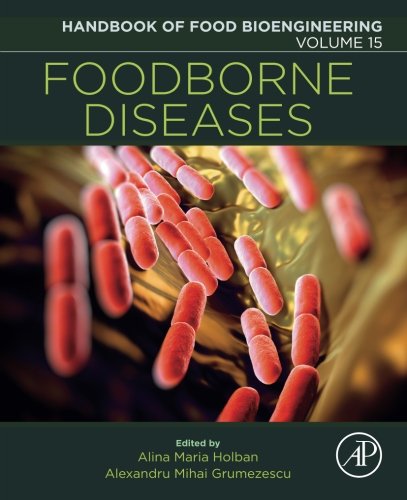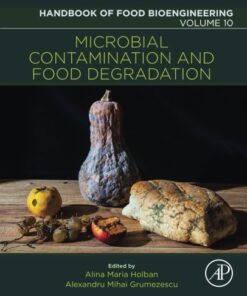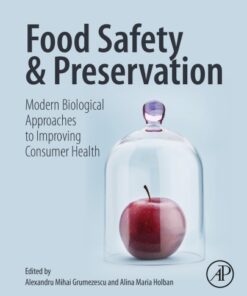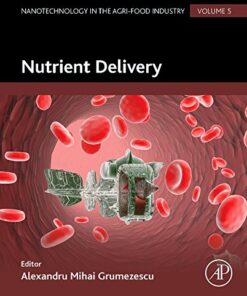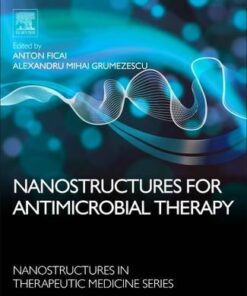(PDF) Foodborne Diseases By Alina Maria Holban
$22.00
Download instantly Foodborne Diseases By Alina Maria Holban, Alexandru Mihai Grumezescu. It is ebook in PDF format.
ISBN-10: 0128114444 ISBN-13: 9780128114445
Preview
This is the PDF eBook version for Foodborne Diseases By Alina Maria Holban, Alexandru Mihai Grumezescu
Table of Contents
Foreword
Series Preface
Preface for Volume 15: Foodborne Diseases
Chapter 1: Microbial Foodborne Diseases
Abstract
1. Section 1. Bacterial Foodborne Diseases
2. Section 2. Parasitic Foodborne Diseases
3. Section 3. Viral Foodborne Diseases
4. Conclusions
Chapter 2: Important Emerging and Reemerging Tropical Food-Borne Diseases
Abstract
1. Introduction
2. Food-Borne Disease: Important Problem in Public Health
3. Examples of Important Food-Borne Diseases
4. Emerging Infectious Diseases and Emerging Food-Borne Diseases
5. Tropical Food-Borne Diseases: Important Tropical Diseases
6. Databases and Computational Online Tools for Emerging and Reemerging Tropical Food-Borne Diseases
7. How to Use the New Technologies for Management of the Emerging and Reemerging Tropical Food-Borne Diseases
8. Further Important Issues Relating to Emerging Food-Borne Diseases
9. Conclusions
Chapter 3: Foodborne Pathogen–Produced Toxins and Their Signal Transduction
Abstract
1. Introduction
2. Foodborne Pathogens (Bacterial, Viral, Fungal, and Algal)
3. Toxins That Target Signal Transduction
4. Signal Transduction
5. Recent Developments
6. Conclusions
Chapter 4: Toxoplasmosis: Prevalence and New Detection Methods
Abstract
1. Introduction
2. Seroprevalence of Toxoplasmosis in Animals in Ukraine
3. Comparison of New Methods of Diagnostics
4. Discussion and Conclusions
Chapter 5: Campylobacteriosis: An Emerging Infectious Foodborne Disease
Abstract
1. Introduction
2. Taxonomy
3. Ecology and Transmission
4. Clinical Relevance
5. Epidemiology and Outbreak
6. Isolation
7. Typing
8. Conclusions
Acknowledgments
Chapter 6: Listeria monocytogenes: A Food-Borne Pathogen
Abstract
1. Introduction
2. Conclusions
Chapter 7: Bacillus spp. as Pathogens in the Dairy Industry
Abstract
1. Bacillus: General Information
2. Bacillus in Clinical Settings (General)
3. Bacillus in Food
4. Quorum Sensing
5. Quorum Sensing and Bacillus spp. Pathogenesis
6. Summary and Future Work
Chapter 8: Staphylococcus aureus, a Food Pathogen: Virulence Factors and Antibiotic Resistance
Abstract
1. Introduction
2. Staphylococcus aureus—General Characteristics
3. Occurrence of Staphylococcus aureus
4. Staphylococcus aureus and Clinical Aspects: An Overview
5. MRSA Strains
6. Staphylococcal Food Poisoning—Outbreaks
7. Presence of Virulence Factors in Staphylococcus aureus
8. Biocontrol and Staphylococcus aureus
9. Preventing Staphylococcus aureus—Other Than Antibiotics
10. Conclusions
Chapter 9: Food-Borne Mycotoxicoses: Pathologies and Public Health Impact
Abstract
1. Introduction
2. Important Factors for Mycotoxin Production
3. Aflatoxins
4. Fumonisins
5. Ochratoxin A
6. Zearalenone
7. Trichothecenes
8. Citrinin
9. Moniliformin
10. Ergot Alkaloids
11. Public Health and Economic Impact of Mycotoxins
12. Conclusions
Chapter 10: Foodborne Botulism From a Systems Biology Perspective
Abstract
1. Introduction
2. Food Matrix System: Biophysical Properties
3. Bacterial Neurotoxin-Producing System
4. Gastrointestinal Tract System
5. Vascular and Lymphatic Systems
6. Peripheral Cholinergic Neuromuscular Junction System
7. Systems Biology of Secondary Reactions
8. Future Directions in Systems Biology of Foodborne Botulism
9. Conclusions
10. Disclaimer
Acknowledgments
Chapter 11: Pathogenic Biofilm Formation in the Food Industry and Alternative Control Strategies
Abstract
1. Introduction
2. Pathogenic Bacterial Biofilms in the Meat Industry
3. Pathogenic Bacterial Biofilms in the Dairy Industry
4. Pathogenic Bacterial Biofilms in the Fresh Produce Industry
5. Pathogenic Bacterial Biofilms in the Seafood Industry
6. Alternative Antibiofilm Strategies for Use in the Food Industry
7. Conclusions
Acknowledgments
Chapter 12: Biosensor-Based Methods for the Determination of Foodborne Pathogens
Abstract
1. Introduction
2. Causes of Foodborne Diseases
3. Detection of Foodborne Pathogens
4. Conclusion
Chapter 13: Molecular Typing of Major Foodborne Pathogens
Abstract
1. Introduction
2. Listeria monocytogenes
3. Salmonella
4. Campylobacter spp.
5. Escherichia coli O157:H7
6. Conclusions
Chapter 14: Environmental Pollution and the Burden of Food-Borne Diseases
Abstract
1. Introduction: The Present Scenario
2. Food-Borne Diseases
3. The Most Common Microbe of Food-Borne Ailment, Salmonella sp.
4. Climate Change
5. Contaminated Water
6. Pesticides and Other Chemicals
7. Crops Contaminated With Antibiotics
8. Polychlorinated and Polybrominated Biphenyls
9. Heavy Metals in Air
10. Poor Sanitation
11. Undernourishment and Overnourishment
12. Genetically Modified Foods
13. Rare Earth Elements: A Future Concern
14. Recommendations and Conclusions
Chapter 15: Foodborne Illness: Threats and Control
Abstract
1. Foodborne Illness
2. Foodborne Pathogens
3. Common Foodborne Illnesses
4. Pathology of Foodborne Illness
5. Detection Techniques
6. Impact on Human Health
7. Prevention of Foodborne Illness
8. Conclusions
Index
